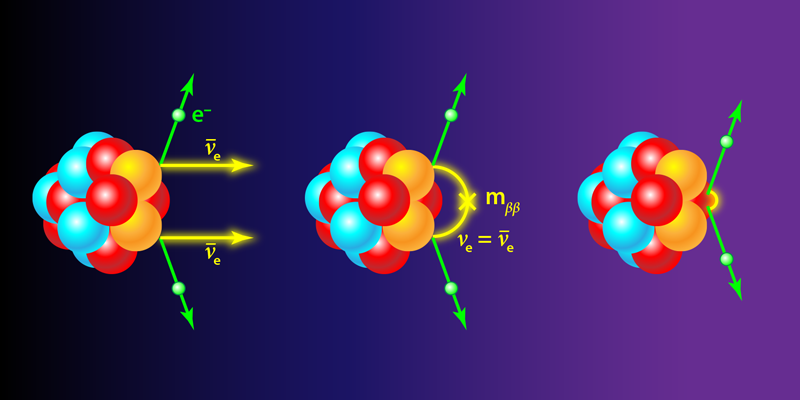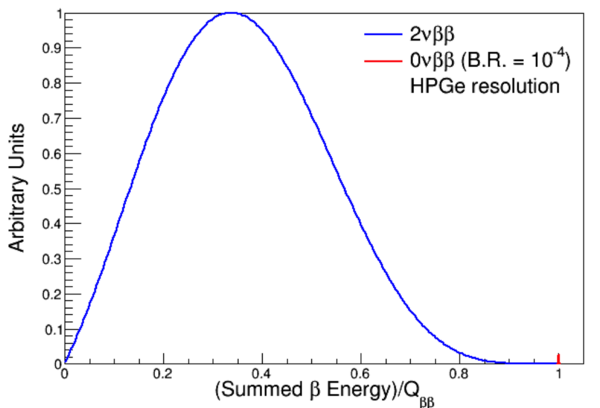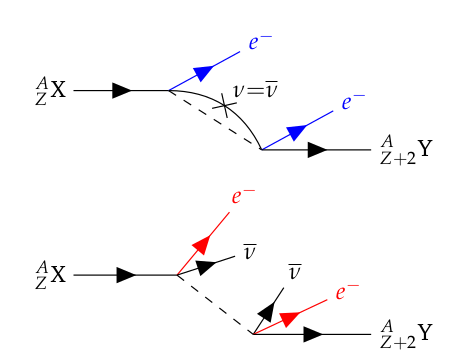Neutrino physics without neutrinos
0νββ/2νββ decay.
“Two-neutrino” double-beta decay (left) is allowed in certain isotopes and involves the transformation of two neutrons into two protons, two electrons, and two antineutrinos. If neutrinos are Majorana particles then a neutrinoless form of this double-beta decay should be allowed. Different models for the decay describe it in terms of the creation and destruction of a Majorana neutrino (center) or of an unknown heavier particle (right).
The role of neutrinos
The Leptogenesis way to account for the matter-antimatter asymmetry in our Universe, implies the violation of lepton-number conservation. To find out if lepton-number conservation is violated, it needs to be observed.
One of the most promising probes of lepton-number violation is double-beta decay, where beta is typically denoted by the greek letter of the same name: Double-ß decay.
- The conservation of the electric charge in this process requires that two electrons are emitted.
- The conservation of lepton-number requires that in this decay, the initial number of leptons and the final number of leptons are the same. Neither protons nor neutrons are leptons, so the initial number is zero. Electrons, however, are in the lepton family; thus the production of two electrons (leptons) implies that one needs to also produce two antileptons to compensate and have a final number also equal to zero. The two anti-leptons observed in this decay are antineutrinos.
- Assuming that the decaying nucleus is initially at rest, the principle of conservation of energy requires that any energy not needed to create the rest mass of the leptons is distributed amongst them as kinetic energy. That is; the decaying energy is shared between the electrons and the antineutrinos. If we measure the electrons' kinetic energy following the decay we would be able to plot a continuous spectrum as the energy from the interaction is split between four bodies. This curve is the signature of the double beta decay.
► How can we observe the violation of lepton number conservation in this process?
Violation of lepton number occurs if no anti-leptons, anti-neutrinos in this case, are produced alongside the electrons in the decay. This would occur if neutrinos and anti-neutrinos are the same particle. When a particle such as a neutrino is the same as its antiparticle, it is called Majorana Particle.
The existence of Majorana neutrinos would imply that in this process the two (anti)neutrinos aren't emitted so the two electrons are created without their antineutrino partners. And if that happens, one would be observing the lepton-number violation and with it, the creation of matter.
The signature of this neutrinoless double beta decay differs from the double-beta because the energy is no longer shared between the two electrons and the two antineutrinos. In the decay without (anti)neutrinos, all the energy is carried by the electrons and so the signature has the form of a peak at the end of the spectrum. The energy value of this peak is the total energy available for this process to happen; this energy is known as the Qßß.
Find out more about Majorana neutrinos below:
-
Is the neutrino its own antiparticle?, Symmetry Magazine
-
How do neutrinos get their mass?, Symmetry Magazine
-
F. Wilczek, “Majorana returns”, Nature Physics, vol. 5, no. 9, pp. 614–618, 2009
Energy Spectrum
Two-neutrino and zero-neutrino double beta decay - 0νββ/2νββ decay
Simulated 0νββ/2νββ decay signal in an HPGe detector. The blue curve represents the double beta decay where the available energy is shared between the two emitted electrons and the two emitted antineutrinos. The red peak would be the signature of the neutrinoless double beta decay where the total energy, Qββ, is carried only by the two electrons.



